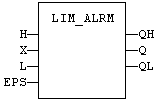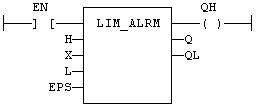![]()
 Function Block
Function Block![]() A function block groups an algorithm and a set of private data. It has inputs and outputs. - Detects high and low limits of a signal with hysteresis.
A function block groups an algorithm and a set of private data. It has inputs and outputs. - Detects high and low limits of a signal with hysteresis.
Inputs
|
Input |
Data Type |
Range |
Unit |
Default |
Description |
|---|---|---|---|---|---|
|
EPS |
REAL |
|
|
|
Value of the hysteresis. |
|
H |
REAL |
|
|
|
Value of the high limit. |
|
L |
REAL |
|
|
|
Value of the low limit. |
|
X |
REAL |
|
|
|
Input signal. |
Outputs
|
Output |
Data Type |
Range |
Unit |
Description |
|---|---|---|---|---|
|
Q |
BOOL |
|
|
TRUE if the signal exceeds one of the limits. Equals to QH OR QL. |
|
QH |
BOOL |
|
|
TRUE if the signal exceeds the high limit. |
|
QL |
BOOL |
|
|
TRUE if the signal exceeds the low limit. |
Remarks
None
FBD Language Example
FFLD Language Example
- In the FFLD
 "Free Form Ladder Diagram" Language, the input rung (EN) is used for enabling the block.
"Free Form Ladder Diagram" Language, the input rung (EN) is used for enabling the block. - The output rung is the QH output.
- The block is not called if EN is FALSE.
IL Language Example
(* MyAlarm is a declared instance of LIM_ALRM function block *)
Op1: CAL MyAlarm (H, X, L, EPS)
FFLD MyAlarm.QH
ST QH
FFLD MyAlarm.Q
ST Q
FFLD MyAlarm.QL
ST QL
ST Language Example
(* MyAlarm is a declared instance of LIM_ALRM function block *)
MyAlarm (H, X, L, EPS);
QH := MyAlarm.QH;
Q := MyAlarm.Q;
QL := MyAlarm.QL;
See Also








